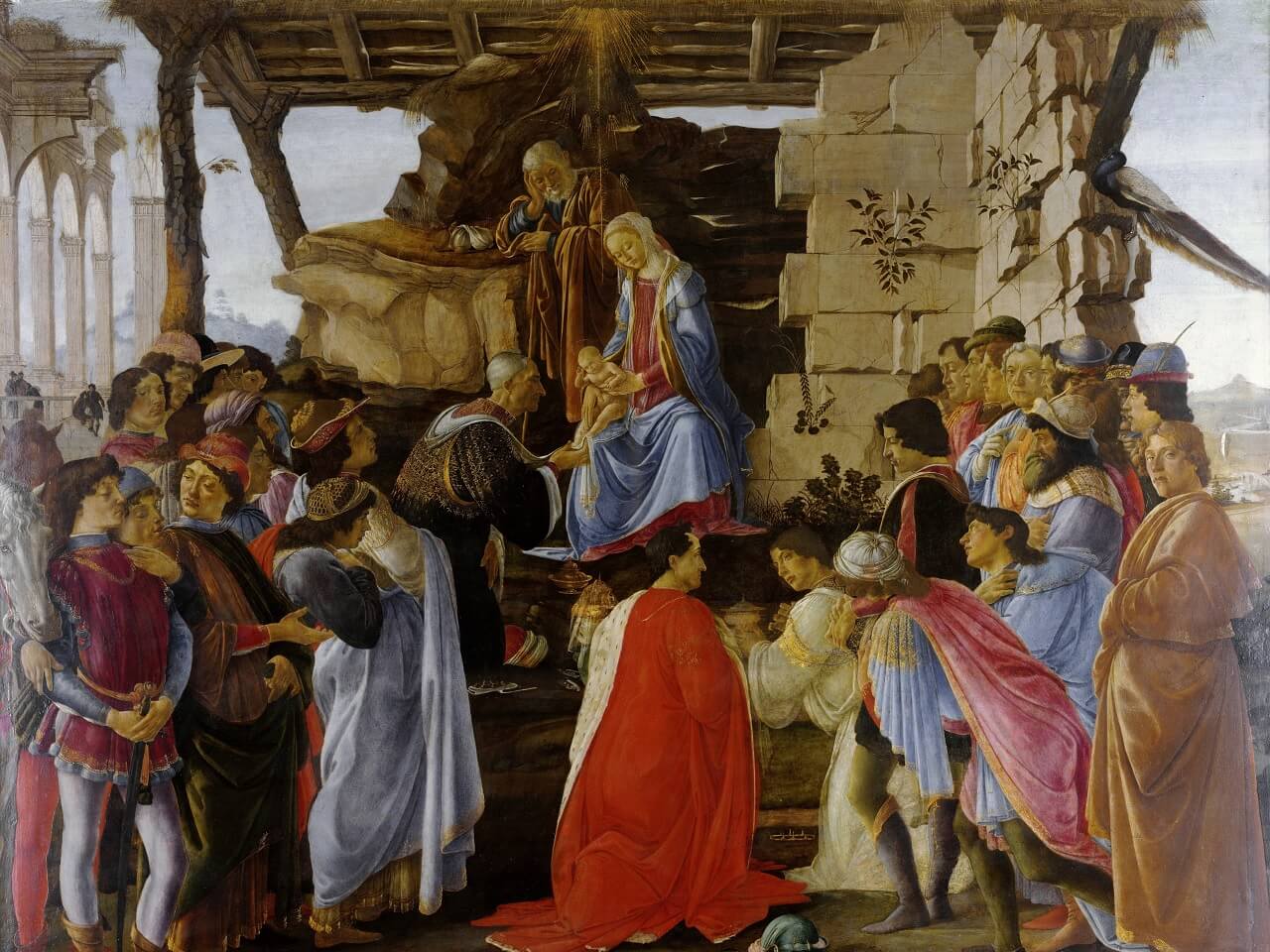In this Christmas season we are invited to worship the Divine Word, the invisible Second Person of the Holy Trinity, who is made visible. “He has come to lift up all things to himself, to restore unity to creation” (Preface of Christmas II).
The idea of “Christ as Jesus of Nazareth, man, not God incarnate” has an impact on our world: “once incarnate, Jesus stops being a God and becomes a man until his death on the cross” (E. Scalfari in La Repubblica of 8 October 2019). These are words that subtly reaffirm what Cardinal Carlo Maria Martini affirmed: “Christ’s Resurrection is not a miracle. The same God, who through the Son assumed a human nature, after dying on the Cross, resumes his divine and immortal nature” (Cdl. Martini in E. Scalfari, Il Dio unico e la società moderna, Einaudi 2019, p. 24).
Both Sandro Botticelli (1445–1510), one of the most individual painters of the Italian Renaissance, and Ottorino Respighi (1879–1936), the composer of orchestral pages that better convey musically the color and atmosphere of Rome, are not contaminated, by the grace of God, by the aforementioned heresies and mistakes and offer us the deeply appreciated gift of Adoration of the Magi.
We mean that altar piece (now in the Uffizi Gallery in Florence) painted by the Florentine painter around 1475 for a chapel in Santa Maria Novella in Florence, where, against the background of ancient ruins:
Wonderful feeling is seen in the first old man, who, kissing the foot of Our Lord, and melting with tenderness, shows very clearly that he has achieved the end of his long journey. The figure of this King is an actual portrait of the elder Cosimo de’ Medici, the most lifelike and most natural that is to be found of him in our own day. The second, who is Giuliano de’ Medici, father of Pope Clement VII, is seen devoutly doing reverence to the Child with a most intent expression, and presenting Him with his offering. The third, also on his knees, appears to be adoring Him and giving Him thanks, while confessing that He is the true Messiah; this is Giovanni, son of Cosimo.
It is not possible to describe the beauty that Sandro depicted in the heads that are therein seen, which are drawn in various attitudes, some in full face, some in profile, some in three-quarter face, others bending down, and others, again, in various manners; with different expressions for the young and the old, and with all the bizarre effects that reveal to us the perfection of his skill; and he distinguished the Courts of the three Kings one from another, insomuch that one can see which are the retainers of each. This is truly a most admirable work, and executed so beautifully, whether in coloring, drawing, or composition, that every craftsman at the present day stands in marvel thereat. (G. Vasari, Lives of the most eminent painters, sculptors & architects, vol. 3, London, Macmillan 1912, pp. 249-250)
Also, in fact, “maestro Respighi, the most aristocratic of our composers, the most brilliant of our symphonists,” as defined by the poet Ada Negri (cf. P. Maurizi, Ettore Patrizi, Ada Negri e la musica, Morlacchi, Perugia 2007, p. 41), stands in marvel thereat, so much so that the work is the central movement of his Botticelli Triptych for small orchestra, composed in 1927. In an oriental atmosphere, the characters’ movement is well rendered by continuous changes of rhythm and transitions from modality to tonality; the delicate, lyrical colors of Botticelli are well evoked by reduced instrumental forces, compared to that of Respighi’s famous symphonic poems (flute, oboe, clarinet, bassoon, horn, trumpet, glockenspiel, triangle, harp, piano, celesta, and strings). We grasp the depth of Christmas — the one according to the Gospel, which faith helps us to understand somehow, that is the coming of Christ into the world, the Incarnation of the Word of God, not other eccentricities — thanks to two known motifs.
The former, Veni, Emmanuel, performed — almost an organ — by flute and bassoon at a distance of two octaves, is a beautiful French Advent hymn of the 15th century, popular in the Anglo-Saxon countries, where it is sung as O come, O come, Emmanuel. The verses are based on the O Antiphons, the seven major antiphons of Advent, which are sung at Vespers between December 17 and 23, and all begin with the vocative “O” (O Sapientia, O Adonai, O Radix Jesse, O Clavis David, O Oriens, O Rex gentium, O Emmanuel — that is, O Wisdom, O Lord, O Rod of Jesse, O Key of David, O rising star, O King of the nations). The lyrics of the refrain prepare for Christmas: “Rejoice, rejoice! Emmanuel shall be born for you, O Israel.”
An episode with an oriental setting, with fragments of the melopea which opened the Adoration, leads us to Tu scendi dalle stelle, the latter Christmas carol included here, the most popular one in Italy and not only Italy, written at Nola in Campania in December 1754 by Saint Alphonsus Mary de Liguori, bishop and doctor. This melody now almost emerges among the Eastern gifts brought by the Magi and remains “until today, when we can still hear it singing in the most remote parishes, the Italian symbol of Christmas” (G. Pestelli, Le Sonate di Domenico Scarlatti, Giappichelli, Turin, 1967, p. 205). Respighi thus ingeniously makes Italian Christmas, as Botticelli does in his tempera on panel, where the Magi, who represent all the people to whom the Lord manifests Himself, come to Bethlehem from Italy instead of from the East to worship the newborn King of the Jews (cf. Mt. 2:1–2).
Those saddened by the fact that within the one Catholic Church a neo-modernist religion today wants to exist together with the traditional one might be consoled with Respighi’s Adoration of the Magi.


